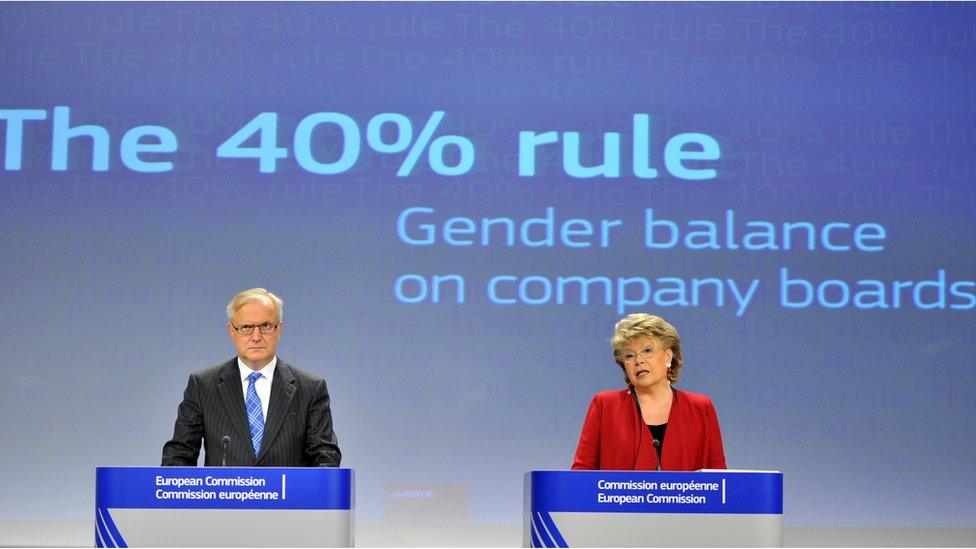100 Women: Do women on boards increase company profits?
- Published

"Having women on company boards leads to better financial performance" came the headlines from report after report, highlighting a business statistic guaranteed to capture the imagination and prompt debate.
What better way to encourage companies to focus on equality and diversity than to make them think of their bottom line?
In the UK, the 30% Club was set up in 2010 with the aim of having women make up at least 30% of the members on every board.
In the US, the Thirty Percent Coalition - a group of people who are chief executives and chairs of their companies - was created to achieve the same thing.
Of course, there are many other - and some say better - reasons to argue for gender equality, but we wanted to look at whether this broadly accepted claim is true - does having more women on the board really mean the company makes more money?
Academics have warned against jumping to simple conclusions.
A report published by Credit Suisse, external last year said companies with at least one woman director received a better return on their investments compared with companies with all-male boardrooms.
They say companies where women made up at least 15% of senior management were 50% more profitable than those where fewer than 10% of senior managers were female.
But Prof Alice Eagly, at Northwestern University in the US, says many of the studies commissioned by corporations are "naive" as they don't consider other variables.

Some European countries have introduced quotas for female board members
She explains that more sophisticated pieces of analysis carried out by academics have shown very small positive correlations between female board members and financial success. But this is an average - in some companies the relationship was neutral and in some it was negative.
And proving causation is far harder. It is difficult to say that it is having more women on boards that makes companies do better, rather than other factors - something corporate reports acknowledge.
This is because companies with more women on boards are different in other ways, too, according to Prof Eagly.
For example, firm size seems to be one of the most significant factors in determining profitability. And larger companies are likely to employ more women at every level.
More innovative companies were more likely to use their talent effectively, regardless of gender. And companies that were already more profitable may have been more able to focus efforts on diversity, she says.
A study looking at the gender make-up of the top management of the US's biggest firms,, external not only their board members, found female representation in top management improves firm performance but only in companies that are "focused on innovation".
'Add women and stir'
And, interestingly, female board members appear to have more of a positive impact on their company's performance in countries where women have more equal rights and treatment overall.
It looks like there is a relationship between more successful companies and those with more women in senior positions in general, but it's not enough to simply "add women and stir", as Prof Robin Ely at Harvard Business School puts it.
Another study from a group of German, Dutch and Belgian researchers found "the mere representation of females on corporate boards is not related to firm financial performance if other factors are not considered". It relies on there being a good company culture too.
If women are in the minority in a room that is hostile to them, they are unlikely to be able to have a positive effect and that applies to other kinds of diversity too, the study suggests.
Focusing on numbers without also addressing structural diversity issues is not enough, according to Prof Ely.

In the biggest US companies on the stock market, around 16% of board seats are held by women
Looking at how many spaces on a board are filled by women doesn't tell you how influential the board is, and it doesn't tell us whether those women are being listened to and allowed to have an impact, Prof Ely points out, as "not all spots on a board are created equal".
There is some evidence that having three women on a board of 12 to 15 people is the tipping point for them to actually be heard and able to have an influence at all. So there are good arguments for the 30% rule - it just doesn't necessarily translate directly to profits.
In fact Corinne Post, a professor of organisation management at Lehigh University, says that board members don't have a direct influence on the bottom line of a company, but they do have a greater influence on corporate social responsibility.
She found that there was a five times stronger correlation between a company having female board members and stronger performance when it comes to ensuring they are environmentally friendly as a company, or involve themselves in philanthropy for example, than the correlation between female board members and profits.
Profitability is highly complex and there's even evidence that chief executives might not have much of an influence on company profits.
"In companies with any women on their board at all, they tend to have between one and three - are you really saying the gender of three people on a board is going to have an impact on the bottom line?" Prof Ely asks.
For Northwestern's Prof Eagly, the most pertinent question is why we would need evidence women bring in more money than men, before they are given equal status on boards.
"Why should you rule out 50% of the population from important jobs. It's about social justice not about profits."



- Published29 October 2015
